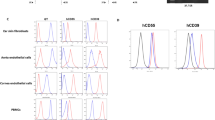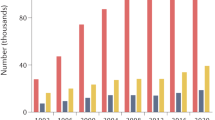Abstract
Xenoantibodies to the galα1,3 gal (gal) epitope impede the use of pig tissues for xenotransplantation, a procedure that may help overcome the shortage of human organ donors. Stable gal chimerism and tolerance to gal+ hearts could be achieved in α1,3-galactosyltransferase (α1,3GT)−/− mice using lentiviral vectors expressing porcine α1,3GT, the enzyme that synthesizes the gal carbohydrate. In this study, we evaluated whether chimerism sufficient to inhibit anti-gal xenoantibody responses can be achieved using lentivectors in non-human primates. Rhesus macaques were transplanted with autologous, α1,3GT-transduced bone marrow (BM) following sublethal irradation. Simian immunodeficiency virus (SIV)- and human immunodeficiency virus (HIV)-1-derived lentiviral constructs were compared. Chimerism was observed in several hematopoietic lineages in all monkeys. Engraftment in animals receiving SIV-based α1,3GT constructs was similar to that achieved using the HIV-1-derived lentivector for the first 2 months post-transplantation, but increased thereafter to reach higher levels by 5 months. Upon immunization with porcine hepatocytes, the production of anti-gal immunoglobulin M xenoantibody was substantially reduced in the gal+ BM recipients compared to controls. This study is the first to report the application of gene therapy to achieve low-level, long-term gal chimerism sufficient to inhibit production of anti-gal antibodies after immunization with porcine cells in rhesus macaques.
This is a preview of subscription content, access via your institution
Access options
Subscribe to this journal
Receive 12 print issues and online access
$259.00 per year
only $21.58 per issue
Buy this article
- Purchase on Springer Link
- Instant access to full article PDF
Prices may be subject to local taxes which are calculated during checkout







Similar content being viewed by others
References
Sandrin MS, Vaughan HA, Dabkowski PL, McKenzie IF . Anti-pig IgM antibodies in human serum react predominantly with Galα(1–3)Gal epitopes. Proc Natl Acad Sci USA 1993; 30: 11391–11395.
Galili U, Shohet SB, Kobrin E, Stults CL, Macher BA . Man, apes, and Old World monkeys differ from other mammals in the expression of alpha-galactosyl epitopes on nucleated cells. J Biol Chem 1988; 263: 17755–17762.
Tearle RG, Tange MJ, Zannettino ZL, Katerelos M, Shinkel TA, Van Denderen BJ et al. The alpha-1,3-galactosyltransferase knockout mouse. Implications for xenotransplantation. Transplantation 1996; 61: 13–19.
Thall A, Murphy H, Lowe JB . Alpha1,3-galatosyltransferase deficient mice produce cytotoxic natural antibodies. Transplant Proc 1996; 28: 561–562.
LaTemple DC, Galili U . Adult and neonatal anti-gal response in knock-out mice for α-1,3-galactosyltransferase. Xenotransplantation 1998; 5: 191–196.
Yang YG, deGoma E, Ohdan H, Bracy JL, Xu Y, Iacomini J et al. Tolerization of anti-galα1–3gal natural antibody-forming B cells by induction of mixed chimerism. J Exp Med 1998; 187: 1335–1342.
Ohdan H, Swenson KG, Kitamura H, Yang YG, Sykes M . Tolerization of Galα1,3Gal-reactive B cells in pre-sensitized α1,3-galactosyltransferase-deficient mice by nonmyeloablative induction of mixed chimerism. Xenotransplantation 2001; 8: 227–238.
Bracy JL, Chase CM, Russell PS, Mauiyyedi S, Colvin RB, Iacomini J . Induction of molecular chimerism by gene therapy prevents antibody-mediated heart transplant rejection. Gene Therapy 2001; 8: 1738–1744.
Kearns-Jonker M, Fischer-Lougheed J, Shulkin I, Kleihauer A, Mitsuhashi N, Kohn DB et al. Use of lentiviral vectors to induce long-term tolerance to gal+ heart grafts. Transplantation 2004; 77: 1748–1754.
Ogawa H, Yin DP, Galili U . Induction of immune tolerance to a transplantation carbohydrate antigen by gene therapy with autologous lymphocytes transduced with adenovirus containing the corresponding glycosyltransferase gene. Gene Therapy 2004; 11: 292–301.
Mitsuhashi N, Fischer-Lougheed J, Shulkin I, Kleihauer A, Kohn DB, Weinberg K et al. Tolerance induction by lentiviral gene therapy with a non-myeloablative regimen. Blood 2006; 107: 2286–2293.
Owens CM, Yang PC, Göttlinger H, Sodroski J . Human and simian immunodeficiency virus capsid proteins are major viral determinants of early, postentry replication blocks in simian cells. J Virol 2003; 77: 726–731.
Kootstra NA, Munk C, Tonnu N, Landau NR, Verma IM . Abrogation of postentry restriction of HIV-1-based lentiviral vector transduction in simian cells. Proc Natl Acad Sci USA 2003; 100: 1298–1303.
Stremlau M, Owens CM, Perron MJ, Kiessling M, Autissier P, Sodroski J . The cytoplasmic body component TRIM5alpha restricts HIV-1 infection in Old World Monkeys. Nature 2004; 427: 848–853.
Strokan V, Molne J, Svalander CT, Breimer ME . Heterogeneous expression of Gal alpha1-3Gal xenoantigen in pig kidney: a lectin and immunogold electron microscopic study. Transplantation 1998; 66: 1495–1503.
Murphy LA, Goldstein IJ . Five alpha-D-galactopyranosyl-binding isolectins from Bandeiraea simplicifolia seeds. J Biol Chem 1977; 252: 4739–4742.
Laukkanen MO, Kuramoto K, Calmels B, Takatoku M, von Kalle C, Donahue RE et al. Low-dose total body irradiation causes clonal fluctuation of primate hematopoietic stem and progenitor cells. Blood 2005; 105: 1010–1015.
Goud SN . Effects of sublethal radiation on bone marrow cells: induction of apoptosis and inhibition of antibody formation. Toxicology 1999; 135: 69–76.
Hanawa H, Hematti P, Keyvanfar K, Metzger ME, Krouse A, Donahue RE et al. Efficient gene transfer into rhesus repopulating hematopoietic stem cells using a simian immunodeficiency virus-based lentiviral vector system. Blood 2004; 103: 4062–4069.
Yoshioka T, Ageyama N, Shibata H, Yasu T, Misawa Y, Takeuchi K et al. Repair of infarcted myocardium mediated by transplanted bone marrow-derived CD34+ stem cells in a nonhuman primate model. Stem Cells 2005; 23: 355–364.
Kawauchi M, Nakajima J, Endoh M, Oka T, Takamoto S . Ontogeny of anti-pig xenoantibody and hyperacute rejection. Transplantation 2000; 70: 686–688.
Donahue RE, Dunbar CE . Update on the use of nonhuman primate models for preclinical testing of gene therapy approaches targeting hematopoietic cells. Hum Gene Ther 2001; 12: 607–617.
An DS, Kung SK, Bonifacino A, Wersto RP, Metzger ME, Agricola BA et al. Lentivirus vector-mediated hematopoietic stem cell gene transfer of common gamma-chain cytokine receptor in rhesus macaques. J Virol 2001; 75: 3547–3555.
Hanazono Y, Terao K, Shibata H, Nagashima T, Ageyama N, Asano T et al. Introduction of the green fluorescent protein gene into hematopoietic stem cells results in prolonged discrepancy of in vivo transduction levels between bone marrow progenitors and peripheral blood cells in nonhuman primates. J Gene Med 2002; 4: 470–477.
Horn PA, Morris JC, Bukovsky AA, Andrews RG, Naldini L, Kurre P et al. Lentivirus-mediated gene transfer into hematopoietic repopulating cells in baboons. Gene Therapy 2002; 9: 1464–1471.
Hu J, Kelly P, Bonifacino A, Agricola B, Donahue R, Vanin E et al. Direct comparison of RD114-pseudotyped versus amphotropic-pseudotyped retroviral vectors for transduction of rhesus macaque long-term repopulating cells. Mol Ther 2003; 8: 611–617.
Kung SK, An DS, Bonifacino A, Metzger ME, Ringpis GE, Mao SH et al. Induction of transgene-specific immunological tolerance in myeloablated nonhuman primates using lentivirally transduced CD34+ progenitor cell. Mol Ther 2003; 8: 981–991.
Rosenzweig M, MacVittie TJ, Harper D, Hempel D, Glickman RL, Johnson RP et al. Efficient and durable gene marking of hematopoietic progenitor cells in nonhuman primates after nonablative conditioning. Blood 1999; 94: 2271–2286.
Rosenzweig M, Connole M, Glickman R, Yue S-P S, Noren B, DeMariaet MA et al. Induction of cytotoxic T lymphocyte and antibody responses to enhanced green fluorescence protein following transplantation of transduced CD34+ hematopoietic cells. Blood 2001; 97: 1951–1959.
Hematti P, Hong B-K, Ferguson C, Adler R, Hanawa H, Sellers S et al. Distinct genomic integration of MLV and SIV vectors in primate hematopoietic stem and progenitor cells. PLOS Biol 2004; 2: e423.
Engel BC, Kohn DB, Podsakoff GM . Update on gene therapy of inherited immune deficiencies. Curr Opin Mol Ther 2003; 5: 503–507.
Montini E, Cesana D, Schmidt M, Sanvito F, Ponzoni M, Bartholomae C et al. Hematopoietic stem cell gene transfer in a tumor-prone mouse model uncovers low genotoxicity of lentiviral vector integration. Nat Biotech 2006; 24: 687–696.
Yam PY, Li S, Wu J, Hu J, Zaia JA, Yee J-K . Design of HIV vectors for efficient gene delivery into human hematopoietic cells. Mol Ther 2002; 5: 479–484.
Sandrin V, Boson B, Salmon P, Gay W, Nègre D, Le Grand R et al. Lentiviral vectors pseudotyped with a modified RD114 envelope glycoprotein show increased stability in sera and augmented transduction of primary lymphocytes and CD34+ cells derived from human and nonhuman primates. Blood 2002; 100: 823–832.
Hanawa H, Kelly PF, Nathwani AC, Persons DA, Vandergriff JA, Hargrove P et al. Comparison of various envelope proteins for their ability to pseudotype lentiviral vectors and transduce primitve hematopoietic cells from human blood. Mol Ther 2002; 5: 242–251.
Logan AC, Lutzko C, Kohn DB . Advances in lentiviral vector design for gene-modification of hematopoietic stem cells, review. Curr Opin Biotechnol 2002; 13: 429–436.
Delenda C . Lentiviral vectors: optimization of packaging, transduction and gene expression. J Gene Med 2004; 6: S125–S138.
Nègre D, Cosset FL . Vectors derived from simian immunodeficiency virus (SIV). Biochimie 2002; 84: 1161–1171.
Hanazono Y, Asano T, Ueda Y, Ozawa K . Genetic manipulation of primate embryonic and hematopoietic stem cells with simian lentivirus vectors. Trends Cardiovasc Med 2003; 13: 106–110.
Nagata M, Takahashi M, Muramatsu S, Ueda Y, Hanazono Y, Takeuchi K et al. Efficient gene transfer of a simian immuno-deficiency viral vector into cardiomyocytes derived from primate embryonic stem cells. J Gene Med 2003; 5: 921–928.
Mangeot PE, Negre D, Dubois B, Winter AJ, Leissner P, Mehtali M et al. Development of minimal lentivirus vectors derived from simian immunodeficiency virus (SIVmac251) and their use for gene transfer into human dendritic cells. J Virol 2000; 74: 8307–8315.
Zahorsky-Reeves J, Gregory C, Cramer DV, Patanwala I, Kyles A, Borie D et al. Similarities in the immunoglobulin response and VH gene usage in rhesus monkeys and humans exposed to porcine hepatocytes. BMC Immunol 2006; 7: 3.
Baquerizo A, Mhoyan A, Kearns-Jonker M, Arnaout WS, Shackleton C, Busuttil RW et al. Characterization of human xenoreactive antibodies in liver failure patients exposed to pig hepatocytes after bioartificial liver treatment: an ex vivo model of pig to human xenotransplantation. Transplantation 1999; 67: 5–18.
Wetzsteon PJ, Head MA, Fletcher LM, Lye WC, Norman DJ . Cytotoxic flow-cytometric crossmatches (Flow-Tox): A comparison with conventional cytotoxicity crossmatch techniques. Hum Immunol 1992; 35: 93–99.
Acknowledgements
We thank Karen Pepper and Denise Petersen of the CHLA vector core facility for preparing the vectors, Ronald Faris at MultiCell Technologies Inc., Warwick, RI, USA for providing the porcine hepatocytes used for immunization and the staff of the University of California National Primate Research Center for assistance and care with the animals. This work was supported by NIH Grants 1R21 AI49922-01 and 7RO1 AI52079-02 (to MKJ) and RR00169 to the California National Primate Research Center.
Author information
Authors and Affiliations
Corresponding author
Rights and permissions
About this article
Cite this article
Fischer-Lougheed, J., Tarantal, A., Shulkin, I. et al. Gene therapy to inhibit xenoantibody production using lentiviral vectors in non-human primates. Gene Ther 14, 49–57 (2007). https://doi.org/10.1038/sj.gt.3302818
Received:
Revised:
Accepted:
Published:
Issue Date:
DOI: https://doi.org/10.1038/sj.gt.3302818
Keywords
This article is cited by
-
Intragraft gene expression profile associated with the induction of tolerance
BMC Immunology (2008)
-
Progress and prospects: genetic engineering in xenotransplantation
Gene Therapy (2008)



